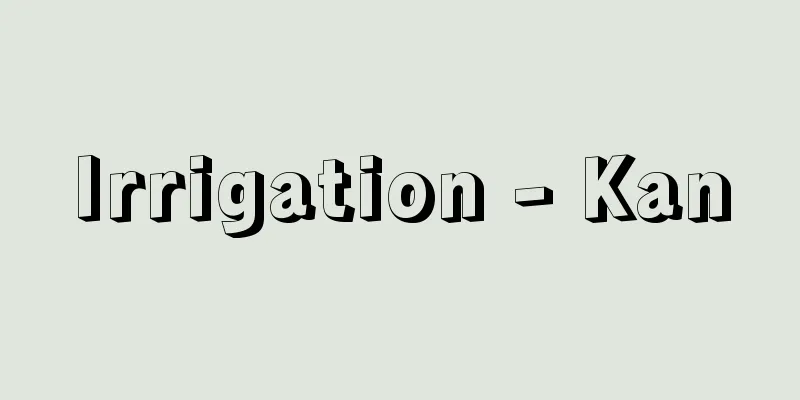Mortgage - mortgage

|
The right of a creditor to receive preferential payment from the value of the real estate used as collateral when the debt is not repaid, while leaving the real estate or other assets used as collateral in the possession of the debtor or a third party (Civil Code Articles 369 to 398-22). [Yasuyuki Takahashi and Masamitsu Nozawa] AttributesA mortgage is no different from a pledge in that it is a secured right created by contract, and a contract that creates a mortgage is called a mortgage contract, and a contract that creates a pledge is called a pledge contract. However, in the case of a pledge, the item that serves as collateral is transferred to the creditor, whereas in the case of a mortgage, the item that serves as collateral is not transferred to the creditor, but remains with the debtor (or a third party). When a pledge is created, the debtor is no longer able to use or profit from that item, but when a mortgage is created, the debtor can continue to use and profit from that item as before. This is the major difference between a pledge and a mortgage. For example, if a farmer borrows money from a bank using his fields as collateral, if the bank takes the fields as collateral, on the one hand, the farmer loses the basis for production, making it difficult for him to repay the loan, and on the other hand, the bank not only reduces the chances of the loan being repaid, but also bears the burden of managing the fields. On the other hand, if the farmer keeps the fields in his possession, the farmer can continue production, making it easier to repay the loan, and on the other hand, the bank does not need to manage the fields. In this way, a mortgage leaves the existing relationship of use intact, thereby allowing the debtor to profit from the property, making it easier for the debtor to repay, while at the same time fully securing the creditor's ability to receive preferential repayment in the event of default. In this respect, a mortgage can be said to be the most rational security system. However, since the object of the mortgage remains in the hands of the debtor (or a third party), the existence of the mortgage is not clearly known to others, and as a result, those who are unaware of the existence of the mortgage may suffer unexpected damages. Therefore, the objects on which mortgages could be established were limited to real estate (Civil Code Article 369, Paragraph 1) and ships (Commercial Code Article 848, Paragraph 1) that had a means (registration) by which the existence of a mortgage could be publicly demonstrated. Therefore, mortgages could not be established on movable property or collective property (for example, all of a company's equipment) that had no means of registration. [Yasuyuki Takahashi and Masamitsu Nozawa] Scope of useThe mortgage system is the most rational system of security, so there has been a demand to use it not only for real estate and ships, but also for other things, and currently the scope of its use has been expanded by many special laws. The first is the so-called foundation mortgage, which is based on the Railway Mortgage Law, Factory Mortgage Law, Mining Mortgage Law, Road Transport Business Mortgage Law, etc., which aims to mortgage the facilities of large companies, mainly real estate. The second is the so-called movable property mortgage. This includes mortgages recognized by the Agricultural Movable Property Credit Law, which aims to mortgage agricultural tools, as well as the Automobile Mortgage Law, Aircraft Mortgage Law, Construction Machinery Mortgage Law, etc. These systems provide for special registration or registration methods, which make the existence of a mortgage public. Facilities that do not have such special mortgage systems (for example, corporate facilities of small and medium-sized enterprises) cannot be mortgaged even today, and in order to use them as collateral, a transfer mortgage (or "sale mortgage"), a method of security that is not stipulated in the Civil Code but is widely used, must be used. It is possible to establish two or more mortgages on one real estate. In that case, they are called the first mortgage, second mortgage, etc. according to the order of registration of the mortgages, which indicates the order of priority of repayment. In other words, the second mortgagee can only receive priority repayment after the first mortgagee has satisfied his/her claim. For example, if B has a first mortgage on a claim of 10 million yen and C has a second mortgage on a claim of 5 million yen on A's real estate, and A's real estate is auctioned for only 13 million yen, B will receive 10 million yen and C will receive 3 million yen. When the first mortgagee has his/her debt satisfied and the first mortgage is extinguished, the previous second mortgage will be promoted to first, the third mortgage to second, and so on. [Yasuyuki Takahashi and Masamitsu Nozawa] efficacyWhen the debtor does not repay the debt on the due date, the mortgagee can receive payment from the object of the mortgage in priority. This is the essential effect of the mortgage. Receiving payment in priority means that if three people, B, C, and D, each have a claim of 5 million yen against A, and only B has a mortgage on a certain real estate owned by A, and the proceeds from the auction of that real estate are, for example, 10 million yen, B can first receive payment of his claim of 5 million yen, while C and D must each settle for 2.5 million yen. The method by which a mortgagee receives priority payment is, in principle, through auction (Article 180 and following of the Civil Execution Law), but the parties may agree to convert the property into cash through a contract, or they may promise that the object will remain the property of the mortgagee. [Yasuyuki Takahashi and Masamitsu Nozawa] SubrogationIf the subject of the mortgage is sold, the mortgage applies to the proceeds, and if it is rented, the mortgage applies to the rent. It is said that the mortgage also applies to claims for fire insurance on mortgaged buildings. The mortgagee can receive payment from the monetary claim first. This is called subrogation. However, in order for this to happen, the claim must be attached before the money is paid (Civil Code Articles 372 and 304). [Yasuyuki Takahashi and Masamitsu Nozawa] Use of mortgaged real estate and mortgagesFor example, even if the subject real estate is leased after a mortgage is registered, the lessee cannot assert a claim against the mortgagee or the purchaser through the execution of the mortgage. However, if the lessee meets certain requirements, the building does not have to be handed over to the purchaser until six months have passed from the time of the purchaser's purchase (Civil Code Article 395). In addition, if real estate on which a mortgage has been created is leased and the lease is registered, and all persons who held mortgages registered prior to that registration give their consent and have registered that consent, the lease may be asserted against the mortgagees who have given their consent (Civil Code Article 387, Paragraph 1). [Yasuyuki Takahashi and Masamitsu Nozawa] [References] | | | | | | | | | |Source: Shogakukan Encyclopedia Nipponica About Encyclopedia Nipponica Information | Legend |
|
担保となっている不動産などを債務者または第三者のもとに残しておきながら、債務が弁済されないときにはその不動産の価額から債権者が優先的に弁済を受けることのできる権利(民法369条~398条の22)。 [高橋康之・野澤正充] 特質契約によって生じる担保物権である点において、抵当権は質権と異なるところがなく、抵当権を生じさせる契約を抵当権設定契約、質権を生じさせる契約を質権設定契約とよぶ。しかし、質権の場合には、担保となる物が債権者の手元に移されるのに対して、抵当権の場合には、担保となる物は債権者に移されることなく、債務者(または第三者)のもとに残されている。債務者は、質権を設定するとその物を使用・収益することができなくなるが、抵当権を設定した場合には、その物の使用・収益を従来どおり続けることができる。この点に、質権と抵当権との大きな違いがある。 たとえば、農民が田畑を担保に銀行から資金を借り入れる場合に、銀行が田畑を担保として取り上げてしまうと、一方では、農民は生産の根拠を失い、資金の返済が困難になり、銀行としても資金が返済される機会を自ら少なくするだけでなく、その田畑を管理するという負担を負うことになる。これに対して、田畑を農民の手元に残しておくと、農民は生産を続けることができ、それだけ資金返済が容易になり、他方、銀行は田畑の管理をする必要がない。このように、抵当権は、従来の利用関係をそのままにしておき、そうすることによって債務者にその物を収益させ、債務者の弁済を容易にすると同時に、債務不履行の場合に優先的に弁済を受ける債権者の権能を十分に確保するものである。この点で、抵当権はもっとも合理的な担保制度であるといえる。しかし、抵当権の目的物が債務者(または第三者)の手中に残されたままであるので他人には抵当権の存在がはっきりわからず、そのために、抵当権の存在を知らない者が思わぬ損害を被る可能性がある。そこで、抵当権を設定しうる物は、抵当権の存在が公に示される手段(登記)のある不動産(民法369条1項)および船舶(商法848条1項)に限定された。したがって、登記の手段のない動産や集合物(たとえば企業設備全部)などには抵当権を設定することはできなかった。 [高橋康之・野澤正充] 利用の範囲抵当権の制度は、担保の制度としてもっとも合理的なものであるので、これを不動産、船舶だけでなく、それ以外にも活用したいという要求が生まれ、現在では、多くの特別法によってその利用の範囲が拡張されている。その第一は、不動産を中心とする大企業の施設を一括して抵当権の対象にしようとするもので、鉄道抵当法、工場抵当法、鉱業抵当法、道路交通事業抵当法などによる、いわゆる財団抵当である。第二は、いわゆる動産抵当である。農業用具の抵当化を目的とする農業動産信用法のほか、自動車抵当法、航空機抵当法、建設機械抵当法などによって認められた抵当権がこれに属する。これらの制度では、特殊の登記または登録の方法が設けられており、それによって抵当権の存在が公にされるようになっている。そのような特殊な抵当制度のない施設(たとえば、中小企業の企業施設)などは、今日でも抵当権の対象とすることはできず、それを担保とするには、譲渡担保(あるいは「売渡担保」)という、民法には規定されていないが広く行われている担保の方法によらなければならない。 一つの不動産のうえに抵当権を二つ以上設定することも可能である。その場合には、抵当権設定の登記の順序に従って一番抵当、二番抵当などとよび、これは優先弁済の順序を表す。すなわち、二番抵当権者は、一番抵当権者が債権を満足させたあとに優先的に弁済を受けられるにすぎない。たとえば、甲の不動産に、乙が1000万円の債権につき一番抵当権を、丙が500万円の債権につき二番抵当権をもっていた場合に、甲の不動産が競売されて1300万円にしかならなかったときは、乙は1000万円、丙は300万円を取得することになる。一番抵当権者が債務の弁済を受けて一番抵当権が消滅すると、従来の二番抵当権が一番に、三番が二番にというように順次昇格する。 [高橋康之・野澤正充] 効力債務者が期日に債務を弁済しないときには、抵当権者は、抵当権の対象となっている物から優先的に弁済を受けることができる。これが抵当権の本質的な効力である。優先的に弁済を受けるというのは、甲に対して乙・丙・丁の3人がそれぞれ500万円の債権をもっていて、乙だけが甲の所有するある不動産に抵当権をもっている場合には、その不動産を競売して得られた代金がたとえば1000万円であったとすると、乙はまず自分の債権500万円の弁済を受けることができ、丙・丁は250万円ずつでがまんしなければならないことをいう。抵当権者が優先弁済を受ける方法は、競売(民事執行法180条以下)によるのが原則であるが、当事者間の契約で換価することにしたり、あるいは目的物をそのまま抵当権者の所有物とすることを約束してもよい。 [高橋康之・野澤正充] 物上代位抵当権の目的物が売却された場合にはその代金、賃貸された場合にはその賃料に抵当権の効力が及ぶ。抵当建物に付された火災保険金請求権にも抵当権の効力が及ぶとされている。抵当権者は、その金銭債権から優先的に弁済を受けることができる。これを物上代位という。ただし、そのためには、金が支払われる前に、その債権を差し押さえなければならない(民法372条・304条)。 [高橋康之・野澤正充] 抵当不動産の利用と抵当権たとえば、抵当権が登記されたあとに、目的不動産が賃貸されたとしても、賃借人は、抵当権者および抵当権の実行による買受人に対抗できない。ただし、その賃借人が一定の要件を満たす場合には、買受人の買受けのときから6か月を経過するまでは、その建物を買受人に引き渡さなくてもよい(民法395条)。 また、抵当権の設定された不動産を賃貸し、賃貸借の登記をした場合において、その登記前に登記をした抵当権を有するすべての者が同意をし、かつ、その同意の登記をしたときは、その同意をした抵当権者に賃貸借を主張することができる(民法387条1項)。 [高橋康之・野澤正充] [参照項目] | | | | | | | | | | | |出典 小学館 日本大百科全書(ニッポニカ)日本大百科全書(ニッポニカ)について 情報 | 凡例 |
<<: Mortgage securities - mortgage securities
Recommend
Kinrin-no-ji Temple
... Yoshino was once again thrust into the histor...
Anomaly - Anomaly
An anomaly is an angle that indicates how far a ce...
Guildford
A city in the west of Surrey County, southeast Eng...
ISK - ISK
…In response to this, socialists, mainly from neu...
Waist - Hip
[1] 〘 noun 〙① In the human body, the lower part of...
Pogonatum inflexum (English spelling) Pogonatum inflexum
...Both Pogonatum commune Hedw. and Pogonatum inf...
Aochi Shien
...Dutch scholar and doctor of the Edo period. So...
Amount of relief - Kifukuryo
A geomorphological term. An index of elevation di...
Windbreak - Windbreak
This is the simplest style of dwelling found among...
Sweet grass
...A perennial grass of the grass family found in...
Insulation paint - Zetsuentoryou (English spelling) coating for insulation
A paint that forms a coating film with high elect...
Hachiro Kanno
He was seen as a leader of the social reform move...
Oral contraceptive
…Also called oral contraceptives. A pill containi...
Loxodonta
…The English name is true elephant. There are fou...
Wood Country
…It is surrounded by the sea on three sides and h...









